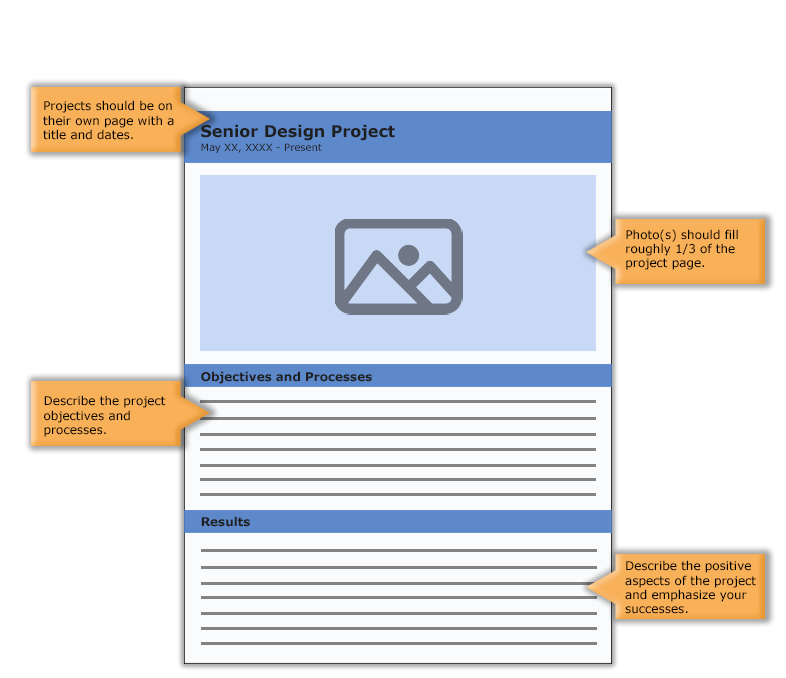Engineering Portfolio
What is an engineering portfolio?
An engineering portfolio is a document or website that highlights your skills, abilities, and experience. A portfolio contains a collection of your academic and personal projects. A small investment of time documenting projects each semester will pay off when you are applying to jobs and internships.
What are the benefits of an engineering portfolio?
A portfolio showcases your projects and accomplishments that often aren’t reflected in your resume. It gives you the opportunity to show potential employers concrete examples of your ability to design and create.
A portfolio will also set you apart from the other applicants. Including a portfolio with your job application is generally not required but will distinguish you in the minds of potential employers.
How do I create a portfolio?
The earlier you begin creating your portfolio the easier it will be. Start building your portfolio as a college freshman and include any prior projects you deem appropriate. Document as you go so project details are fresh on your mind. When you are working on a project take photos and write down pertinent information. Include the project’s objectives, the process you used to meet those objectives, any obstacles you overcame, and how your project was successful.
The layout of your portfolio should be simple and can include the following:
- Title page
- Index (optional)
- Personal introduction (optional)
- Resume
- Project 1
- Project 2
- Etc.
Title Page & Index
Always include a title page with your name, major, and contact information. Including a photo of yourself is optional. After the title page, you may choose to add an index.
If you choose to include an index, make sure to update it any time you adjust the content or order of your portfolio. You can use the order of your projects to highlight skills and knowledge. If one of your projects relates to a particular job, place it at the beginning of the project section.
Personal Introduction & Resume
You may also choose to have a personal introduction. If so, include anything you want a future employer to know and any information that may give you an advantage. For example, you may have hobbies or experience in professional organizations you want to highlight.
Though you’ve probably already submitted a resume with your application, place your resume in your portfolio for the reviewer’s reference. Make sure the resume in your portfolio is up-to-date and matches the resume you submitted with your application.
Project Pages
Select a few projects to include in your portfolio. Each project should be on its own page with a title, start and completion dates, a description, and photos. In the description, include the objectives and the process. Always focus on the positive aspects of the project and emphasize your successes.
Photos are one of the most important features of a portfolio because they allow the reviewer to see the work you have done. Include at least one photo with each project and have the photo(s) fill about one-third of the page.
Project Page Example

How often should I update my portfolio?
Update your portfolio each semester or upon completion of a project. This will reduce the need for big updates and make the process less time-consuming. Additionally, the details of the project will be fresh on your mind, making them easier to recall.
It is very important to update your portfolio before submitting it with an application. You should tailor your portfolio to each job for which you are applying. Consider carefully which projects best relate to the position and include those projects in your tailored portfolio. Emphasize different aspects of your projects based on the experience you want to demonstrate to your potential employer.
How do I use my portfolio to get an internship or job?
Employers do not normally ask for portfolios; however, most will accept them. If you can submit multiple documents in an application, submit your resume and portfolio as two separate documents.
When you have an interview, come prepared with a printed copy of your portfolio, resume, and cover letter. Make your portfolio look professional by printing it in color and using a quality binding method. Use your portfolio during your interview to explain your work as you answer interview questions. Reference the photos as this will help the interviewers understand and visualize the scope and detail of your projects.
Additional Resources
Career Services and the Engineering Writing Center
Contact Career Services for help with project-page content and to practice using your portfolio in mock interviews. For assistance with writing and grammar, schedule an appointment with the Engineering Writing Center.
5 Principles for Landing Your Dream Job
Dr. Hunsaker, USU mechanical engineering professor, created a course with important tips and tricks he learned from his own job-searching experiences, including how to create an engineering portfolio.
You can find his course, 5 Principles for Landing Your Dream Job, by navigating to the modules tab in your Advising Canvas course. Principle 4 of the course contains more information about how to create your portfolio.

